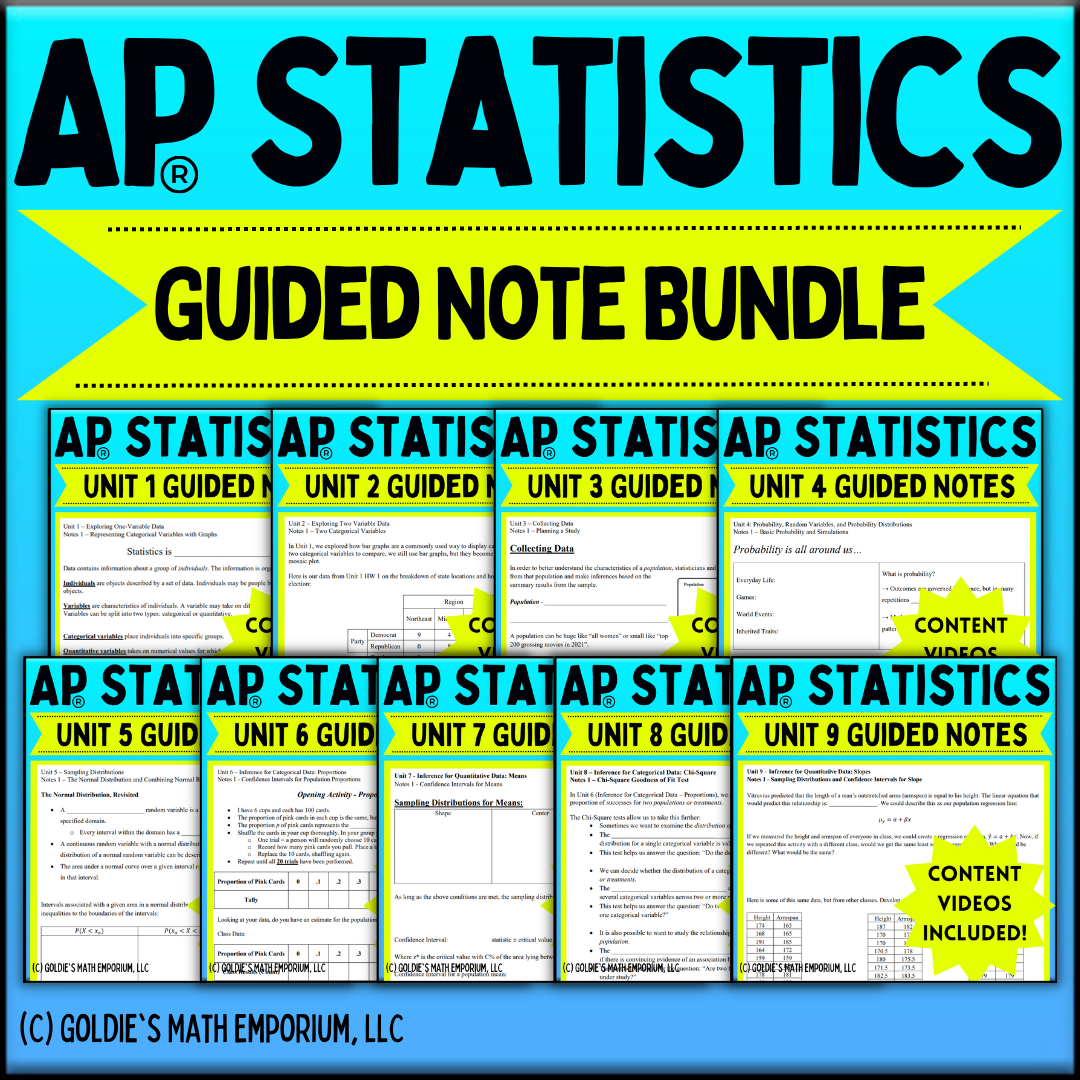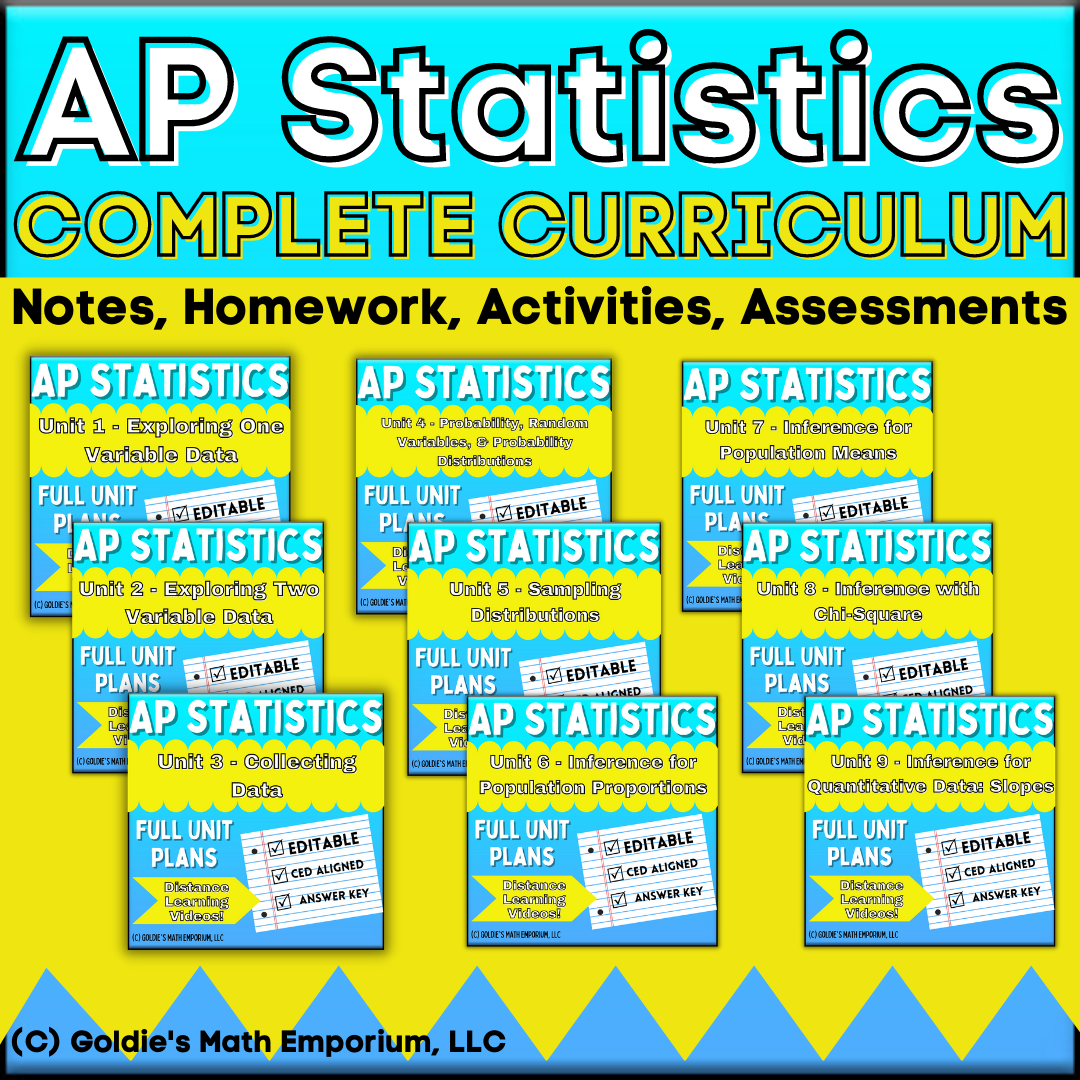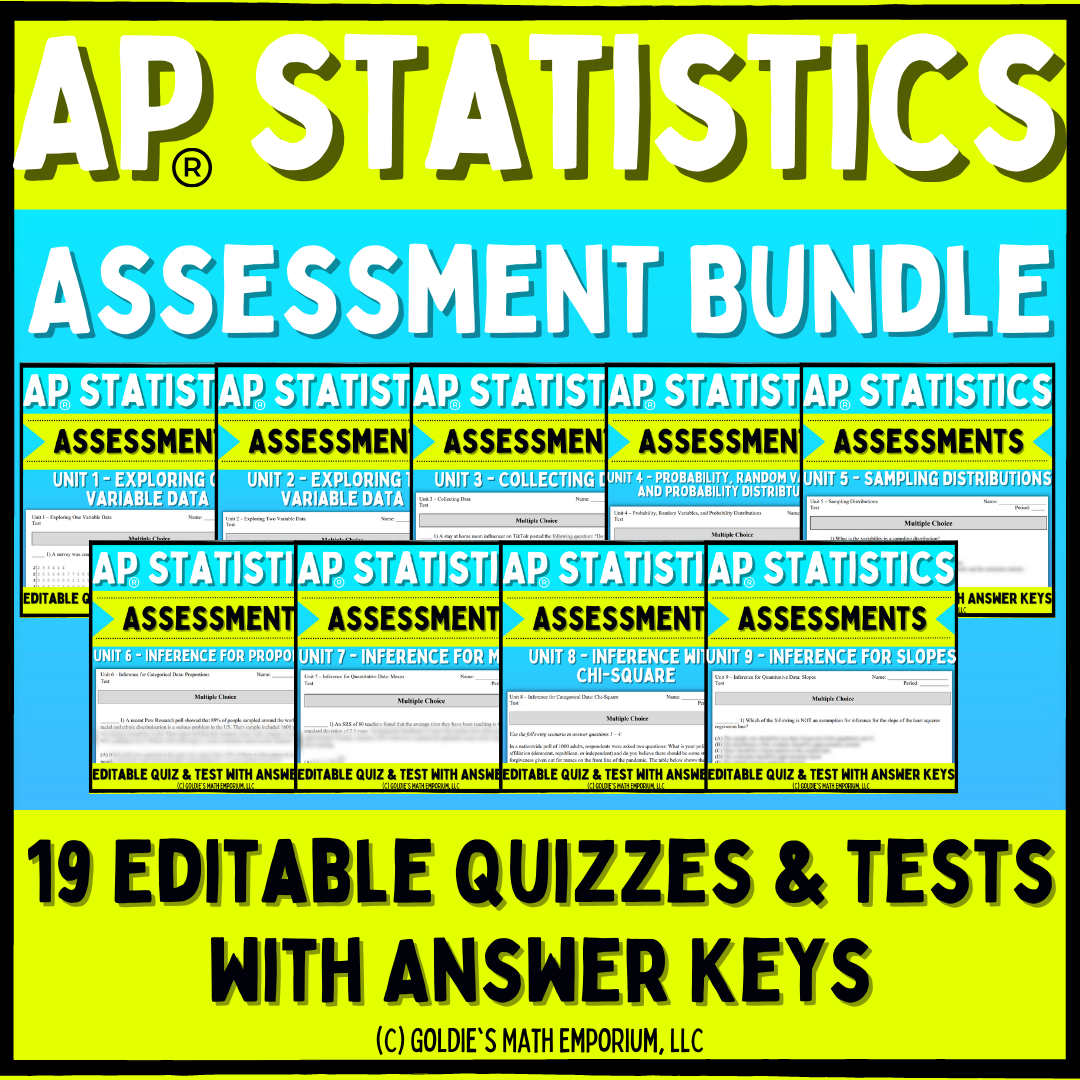No more numbers?! Unit 3 in AP Statistics is all about designing studies and experiments correctly, so any data we gather is trustworthy and relevant. What does that look like in AP Statistics? NO NUMBERS! {I refuse to say “no math”, because math is and can be, writing and explaining as well}
The unit is called “Collecting Data” or some teachers will call it “Sampling and Experiments”. The entire unit is vocab, understanding sampling methods, understanding experimental design, and how to correctly do these things so you get consistent and reliable data. Students will usually start to panic at this point, because these are students that strive off of single, correct answers, but this is where I remind them of the exciting part of statistics: almost every problem is now going to have some real-world context behind it. Almost every problem they see will sound like something they have read before or heard of in a TikTok or YouTube video. Remind them that this is the basis for everything we do in statistics; every study starts with a good sampling method or a well-designed experiment. Researchers need to have these things or any results they get and analyze are going to be inaccurate.
So, how do we set and construct this unit so students are set up for success the rest of this class? Keep reading to see how I set up this unit in my classroom and, at the end, I have a few freebies to help you plan and teach this unit!

Notes
First, my note packet for this unit is split up into four sections of notes. Here is a list of the notes and what is discussed in each section:
Notes 1 – Planning a Study
- Observational Study Vocab
- Sampling Methods
Notes 2 – Potential Problems with Sampling
- Sources of Bias
- Sampling vs Non-sampling Error
Notes 3 – Selecting Random Samples and Introduction to Experiments
- Table of Random Digits
- Observational study vs Experiment
Notes 4 – Experimental Design
- Principles of Experimental Design
- Experimental Terms
- Lurking vs Confounding Variables
- Experimental Design
- Scope of Inference
Notes 1 through 3 take about a single 50-minute class period to complete, while Notes 4 takes about two class periods. Students come in and there will be a bell ringer on the board for them to answer. This is sometimes a fun question (“If you could have any superpower in the world, what would it be a why?”) or a multiple-choice question taken from the AP classroom. Once class starts, we discuss the bell ringer and then jump right into the notes. I print off note packets at the beginning of the unit for my students to have.
Homework
By now, if you have been reading my posts, you know that I like to give homework out via homework packets. It’s a lot for me to grade homework every night with all of the preps I have, so for my AP students, I like giving out all of the homework at once and have them turn in that packet the day of the test for completion points. I post the answer keys to the homework assignments in Google classroom, so as we go through the unit, I tell students what homework should be completed on what day and it is up to them to complete it. They can check their answers in the Google classroom, and then they know that they should come to me if they have any trouble with the questions.
I’m a big believer, that, in an AP class, students should start learning how to manage their own homework and learning. I love letting my students self-advocate for their learning and this is one of the big ways that I do that.
Projects and Activities
I have a few projects and activities that I like doing to really get the students hands-on when it comes to sampling and experiments. I start with an intro activity to the unit and sprinkle some of these throughout the unit too. The list below shows all of the projects and activities that are included in my curriculum with a short description of what they’re going to do.
Show Me the Money Activity
- This is a great introduction activity to random sampling and how we need random sampling in order to get accurate data. I use this on Day 1 of Unit 3.
Pumpkin Picking Sampling Activity
- This activity demonstrates the different types of random sampling methods and what situations would require different sampling methods.
- You can purchase this individual activity from my shop here!
Rolling Down the River Activity
- This activity is also used to talk about different types of random sampling methods. It is similar to the pumpkin picking activity.
Can You Taste a Difference Activity
- With your students, you will design a completely randomized experiment to see if you can taste the difference between regular M&M candies and generic chocolate candies.
- You can purchase this individual activity from my shop here!
Ethics in Experiments Lesson
- This is an additional lesson you can use to teach what ethical considerations need to occur when conducting an experiment. The second half of the lesson discusses 5 of the most famous unethical experiments in psychology.
Sample Survey Project
- Students will design a survey to test a bias of their choosing. They will describe how they randomly select people to complete their survey and will then report their results in a visual aid.
Design an Experiment Project
- Students will design their own experiment, carry it out, and report their results in a lab report. This is one I haven’t done for a few years because it takes so much time, but it is a great one to keep in mind for the end-of-the-year project! Students not only can design an experiment but by the end of the year, they can also perform inference on the data and report the findings.
Assessments
I give one quiz and one test in this unit. The quiz comes after the first two sets of notes and the test comes on the last day of the unit. Traditional, teachers use a full class period for the quiz and then use a full class period for the test. While this definitely works for some teachers, right about now is when other teachers are feeling a big time crunch to get through Unit 4 by the end of the first semester. If you are struggling with timing in your class, here are some ideas for modifications you can do:
- Since Notes 4 usually takes 2 class periods, instead, assign my video as homework and have the students complete the notes on their own. Then, on a single class day, do a quick review and then have them start working on the homework assignment.
- Taking a whole class period for a quiz can be hard, so you can make it a take-home quiz and have them turn it in the next day.
- The test is long, and because of all the reading, some students might not finish on time. You can consider cutting down the test to 10 MCQs and keep the 2 FRQs. You can use the 10 questions you cut out for review somewhere else in your lesson too
- I spend 3 days before the test doing an activity, spending a class period setting up the Unit project, and then a full class period reviewing the material and working on the test review. In a time crunch, you can easily cut out one of those days so you can complete the unit on time
When I grade the unit 3 assessment, I do one point for each multiple-choice question, and then a E/P/I grade for each of the two FRQs. An “E” on the question will earn 5 points, a “P” will earn 3 points, and an “I” with an attempt at answering the question will earn 1 point. If they do not attempt it, they get a 0. The E/P/I scale is how the AP exam FRQs are graded. “E” stands for “Essentially Correct”, “P” stands for “Partially Correct”, and “I” stands for “Incorrect”. I give an “E” if the student got the question correct, maybe with a tiny mistake, but they clearly know what they are talking about. I give a “P” if they get some answers correct, but some answers are incorrect and it is hard to see if they actually know what they are talking about. “I” for everything else! If they get all 20 multiple choice questions correct and an “E” on questions 21 and 22, they will get 30 points total. From here, it depends on how harsh of a grader you are in your AP class! E/P/I scale can be subjective without an extensive rubric (and even then it is still hard), but trust your professional judgment as a teacher when it comes to your student’s work.
Have fun!
If you’re feeling the time crunch for unit 3, don’t stress! Remember the goal is always to get through unit 4 by the end of the first semester before you leave for winter break. By doing this, you will allow yourself to still get in a good 3 weeks of exam review before May. If you don’t, remember that you have three open weeks before the exam in May, and you can absolutely fit in the content!
This is a fun unit, once you get comfortable with it, so use the activities and my lesson videos to help you out! If you are interested in purchasing the complete unit, you can check out my listing here. Otherwise, here are some FREE resources I have to help you teach this unit. Enjoy!
Click on an image below to be taken to some AMAZING Unit 3 resources!









0 Comments